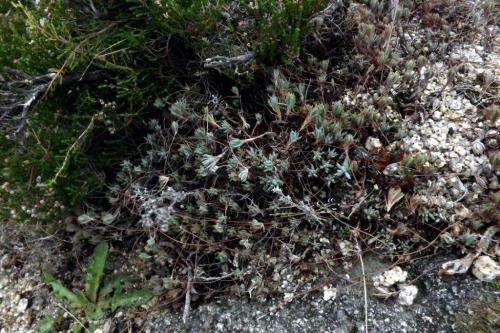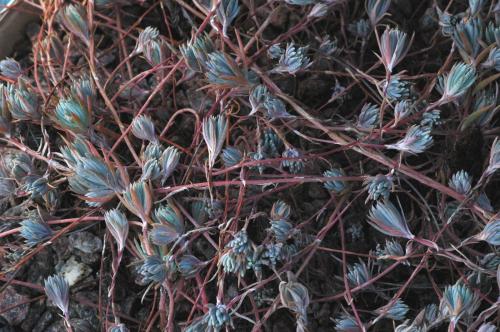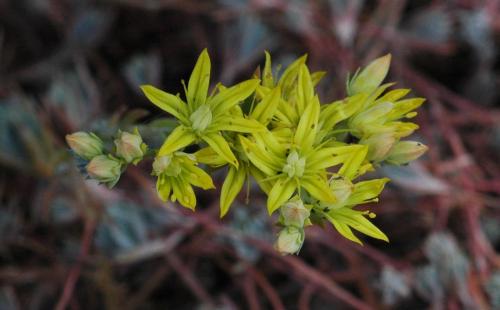PRUINATUM (Brotero) Grulich, 1984
Synonyms :
Sedum pruinatum Link ex Brotero (1805)
Sempervivum pruinatum Sprengel (1825)
Distribution : Western Iberian Peninsula (Portugal, Spain).
Description (according to 't Hart & Bleij in IHSP, 2003) :
Glabrous perennial herbs, strongly pruinate troughout; non-flowering branches procumbent, long and slender, with terminal summer-dormant buds (propagules) with 5 rows of densely imbricate leaves.
Leaves imbricate, linear, 10 - 19 mm, mucronate, basal spur truncate (not 3-lobed).
Inflorescences : Flowering branches erect, 7 - 30 cm, inflorescences terminal lax cymes with 2 - 3 ascending monochasial branches, glabrous, erect in bud, bracts leaf-like.
FIowers (5- to) 6- (to 7-) merous, subsessile, sepals basally connate, equal, triangular-ovate, acuminate, (4-) 5 (-6) mm, petals free, oblong, (pale) yellow, (8-) 9 (-12) mm, spreading, filaments yellow, densely papillate at the base, anthers yellow.
Cytology: 2n = 26 (plus aneuploids with 2n = 27, 28, 30, 36).
Ray Stephenson (Sedum, Cultivated Stonecrops, 1994, pp 121 - 122)
Petrosedum pruinatum, a very distinct member of the genus Petrosedum is unlikely to be confused with any other stonecrop. Like P. amplexicaule, this species grows in winter and is dormant in summer. It dries up but retains its leaves. The thin, threadlike stems become brittle, and often snap, casting propagation material into the wind. Terminal, conical tufts, often on long, straight, bare stems, grow as new plants in late September. Leaves are entirely covered with a thick, white, pruinose cuticle, and flowers are usually 6-partite with pale yellow stellate petals.
Habitat : According to 't Hart (1978), this species grows in two disjunct colonies in Portugal: in the north, along the River Homen (sic) ; and in the Algarve region (deep south) among heath. I have located sites on three sides of the Serra da Estrela in Central Portugal on vertical cliff faces at low altitudes and in Natural Parque do Alvão. After extensive exploration of the Algarve, I believe the similarity of P. pruinatum to P. amplexicaule has resulted in incorrect identification of plants in southern Portugal.
Main points of distinction : Summer-dormant conical leaf clusters on very thin, brittle stems are the best indicator. In winter, the species is a little more difficult to recognize, although the low, open, sprawling, pruinose growth helps (Petrosedum characteristics, fig. 1e). P. amplexicaule has thickened propagules, a feature not shared with this species. P. pruinatum has a spindly straight inflorescence topped with only a few light yellow flowers in contrast to P. amplexicaule with reflexed inflorescence and more golden-yellow flowers.
Variation : The basic chromosome number is x = 13, according to 't Hart (1978), who also has encountered plants with 2n = 26 (the most common), 2n = 27, 28, 30, and 36.
Horticulture : The main plant usually dies each year, leaving offsets on long straight stolons to root and regenerate. It is a very untidy plant, almost impossible to contain in a pot, but in the wild it tends to grow in nearly two dimensions with stolons hugging the cliff faces. In this way it colonizes the cliff in all directions, and the network of stems and tufts is very pretty. I have not been able to simulate this situation in cultivation, but am working on it. The hardiness of this species in extreme areas is questionable, but I have always grown it outdoors without protection.

Serra Alvão, Portugal.


Photos Ray Stephenson